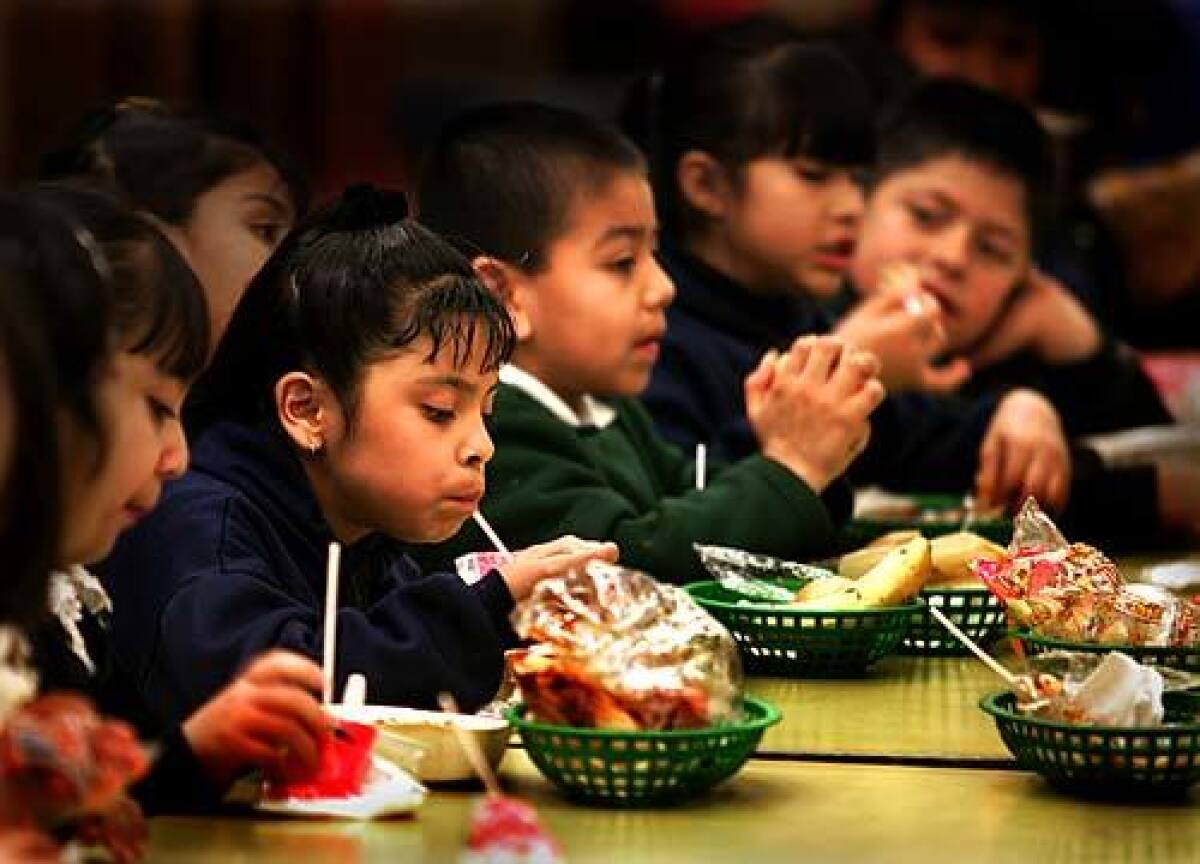Fat American Children: Many Causes, a Lifetime of Effects

- Share via
The percentage of American children who are overweight or obese has been growing for decades, and now nearly one in three has a body mass index that’s greater than normal. Although evidence suggests that obesity rates are leveling off overall, for some groups of kids — especially poor or minority kids — the problem continues to grow, according to a study published Tuesday in the journal Health Affairs.
Using data from the 2007 National Survey of Children’s Health, the study showed marked regional differences. The five states with the highest rates of overweight and obese kids are all in the Southeast — top-ranked Mississippi (44.4%), Arkansas, Georgia, Kentucky and Tennessee. Minnesota and Utah were tied with the lowest rates (23.1%).
But when researchers further divvied up state-level numbers by race and socioeconomic status as well as things such as TV-watching behavior and access to parks, they found even greater disparities.
In an interview, lead study author Christina Bethell, a health policy expert at Oregon Health and Science University in Portland, explained the significance of her new findings and the questions they raise. Here is an edited transcript of that interview.
What are some of the biggest factors that are linked to kids becoming overweight and obese?
We found the highest rates of overweight or obesity in kids who were black (41.1%), Spanish-speaking Hispanic (45%), living below the poverty level (44.8%), publicly insured (43.2%) and those who did not participate in activities outside of school (40.3%).
The likelihood of being overweight or obese was greater if a child has a TV in his bedroom or watches more than two hours a day (41% greater odds), if he’s from a single-mom family (25% greater odds) or if he lives in a neighborhood without a park or recreation center (21% greater odds).
What were some of the biggest surprises in your study?
National obesity rates can mask what’s happening in minority populations. So while the overall prevalence of kids who are overweight or obese didn’t change between 2003 and 2007, our study showed that it increased for publicly insured children.
It’s somewhat of a surprise to the extent that there have been efforts to reduce childhood obesity, and a good amount of that funding has been targeted to vulnerable populations. One could argue that we would have expected to see a decrease.
Another surprise was how much disparities varied across states. In Alaska, poor children were only 1.2 times more likely to be overweight or obese than better-off children. But in Arizona, the difference in rates was 3.8. Why would it be different to be poor in Alaska than in Arizona? That’s basically what it amounts to — it’s not the same being poor in one state as it is in another.
What does the future hold if obesity levels continue to rise in disadvantaged populations?
For vulnerable children, the picture can start to look bleak. It means adding the physical health burden of obesity to the already existing burdens of poverty and discrimination. The majority of overweight or obese children in our study already had at least one of the other chronic health conditions we asked about, such as diabetes, asthma, attention deficit hyperactivity disorder and depression.
Our study also found that obese children were twice as likely to have had to repeat a grade in school compared with children who are neither overweight or obese. Over time these types of impacts can really add up to impact the lifetime health and success of a child.
On a societal level, the projected loss of years of quality of life and added costs of future healthcare costs due to continued effects of childhood obesity into adulthood are astounding. Another paper in the same journal projected costs and years of quality of life lost and concluded that even large investments with small impact on numbers of children who are obese would be well worth the investment — that’s how big the lifetime impact and societal costs are. One way or another, everyone pays dearly for this epidemic — except perhaps specific companies that gain by marketing their unhealthy products to children.
What other factors might contribute to kids becoming overweight or obese?
I think it ends up pointing to a lot of other issues that we don’t measure and couldn’t take into account — things like norms of physical activity at schools and the quality of preventative health services. And, of course, there’s a lot of things going on inside the home where day-to-day decisions are made about eating and activity. Given the higher overall rates of overweight and obese kids in Southeastern states, it is hard to escape the idea that it’s related to culture or community norms.
One of the original titles of our paper was “Beyond Socioeconomic Status.” It’s a key point because, even though it is true that you’re more likely to be overweight or obese if you’re in one of those lower socioeconomic groups, the biggest proportion of children who are overweight or obese in the country are not in one of those so-called disadvantaged groups. Most of them have private insurance, most of them have access to parks and recreation centers and most of them are not poor.
How can public health officials and policymakers use your findings to address the problem?
All this data is available for each state in the U.S. through the national Data Resource Center for Child and Adolescent Health at https://www.childhealthdata.org. My team runs this, and it’s supported by the federal Maternal and Child Health Bureau.
For example in California, 30.5% of children are overweight or obese — very close to the national average of 31.6%. By race, 39.9% of Hispanic kids are overweight or obese, as are 34.4% of black kids and 18.4% of white kids.
Each state should be looking at what’s going on: How big is the problem? With whom? Does it vary, and why? How might public health, health insurance and school programs play a role? What about parks and recreation centers and transportation and community safety? All of it matters, and all of it works together.






